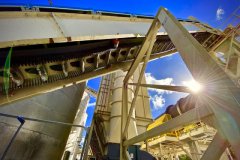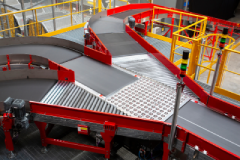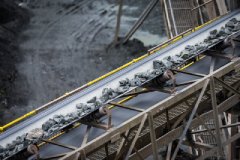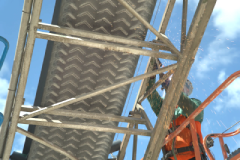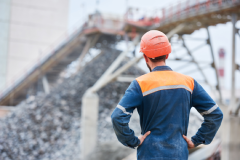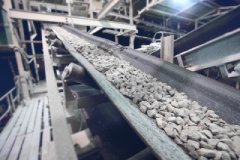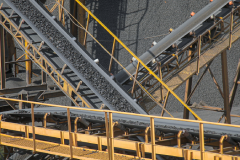Conveyor Belt Compounds
At Davis Industrial, we understand the critical role that conveyor belt compounds play in ensuring the longevity and efficiency of your systems. We offer a wide range of compounds, including PVC and rubber, each with its unique characteristics designed to meet your specific needs.
Rubber Compounds
Our rubber compounds, encompassing natural and synthetic variations, offer similar physical properties to PVC but with an emphasis on resilience. This makes them ideal for materials like gravel, rocks, and more.
Natural Gum - RMA Grade 1
Natural rubber (polyisoprene) offers an excellent balance of properties which result in outstanding performance in many demanding mechanical applications. It offers high resilience, high tensile strength, and excellent flexibility at low temperatures. When properly compounded with appropriate additives, natural gum can exhibit excellent abrasion/wear resistance, and good oxygen, ozone and sunlight resistance. It does have drawbacks however, such as: lack of oil resistance, and poor heat aging characteristics.
Natural gum is recommended for those applications requiring superior resistance to cutting, gouging, and abrasion. It is particularly effective for use when conveying heavy logs, hard rock ores, glass cullet, trap and other sharp, abrasive materials.
SBR General Purpose - RMA Grade 2
SBR (styrene butadiene rubber) is a polymer which has been the general purpose rubber of the belting industry for many years. it is recommended for the majority of above ground applications, including aggregate, log handling from the wood yard to debarkers, run of mine and sized coal, coal mine refuse, crushed ores, phosphate, potash, salt, sand, crushed materials and general mining applications.
It is a tough rugged, compound which ideally meets the demands of the mining industry. However, it does have a limitation of poor oil resistance but is compounded for medium heat resistance and good oxygen, ozone and sunlight resistance.
MSHA-FR (Below Ground)
MSHA-FR (Above Ground)
Same as above but compounded to be sunlight and ozone resistant. Will retain flexibility at the lower temperatures anticipated in above ground applications.
MSHA-FOR (Fire & Oil Resistant)
A premium formulation which will meet the current flame retardant requirements and which will provide oil resistance for applications like oil treated coal in power plants. It is ideal for above ground coal preparation plants, coal fired steam plants, etc.
MOR (Moderate Oil Resistant)
A premium formulation designed to provide moderate oil resistance. It will withstand attack in moderate oil environments such as wood chips, oil treated coal, and whole grains like corn and soybeans.
SOR (Superior Oil Resistant)
SOR (special oil resistant) is a premium formulation made especially for applications requiring extreme oil resistance. It has excellent abrasion, tear, ozone, and water resistance and is highly resistant to mineral oil and most other oils that cause swelling and sponginess in other elastomers. SOR is recommended for handling oily metal parts, crushed soybeans, and other materials where animal or vegetable fats are a deteriorating factor.
CGH (Classic Grain Handler)
Classic Grain Handler is a specially formulated rubber which has been specifically engineered for handling grain products including wheat, corn, whole soybeans, cotton seed, flax seed, and sunflower seeds. When exposed to oily grains, CGH will not soften, peel, or flake. CGH is fire resistant (per MSHA-2G and ASTM 0- 378), as well as moderately oil resistant and static conductive. Electrical resistance is less than 1 megohm – exceeds RMA standards substantially.
UGH (Ultra Grain Handler)
A premium compound designed to convey oil treated grain, crushed soybeans and other materials where mineral, animal or vegetable fat are a deteriorating factor and where combustion properties are a concern. UGH also meets MSHA 2-G and ASTM D-378 flame retardant requirements and OSHA requirements.
MHR (Moderate Heat Resistant)
EPDM (ethylene propylene diene methylene tripolymar) blend offers excellent resistance to the effects of high-temperature payloads and abrasive materials in a range up to 350 degrees Fahrenheit. Resists hardening and cracking, and is oxygen, ozone and sunlight resistant.
EPDM (Heat Resistant)
EPDM (ethylene propylene diene methylene tripolymer) offers excellent resistance to the effects of high-temperature payloads and abrasive materials in a range up to 350 degrees Fahrenheit (fines) and 400 degrees Fahrenheit (lumps). Excellent resistance to hardening and cracking within its recommended temperature service range is offered. It is highly chemical, oxygen, ozone and sunlight resistant.
OHR (Oil & Heat Resistant)
OHR is an oil and heat resistant compound designed to service applications or combinations of high temperature and oil. It has good abrasion resistance and retains flexibility at temperatures to 350 degrees Fahrenheit. This compound is recommended for conveying hot asphalt, paving mix, carbon/pitch mixes, and any hot service involving petroleum oils. It is ideally suited for applications in oil extractors and other plants handling oily grains and seeds where the belt must withstand the effects of vegetable oils at high temperatures as well as moisture from steam.
Nitrile-Buna N
Nitrile (Butadiene Acrylonitrile) is a copolymer recommended for applications requiring excellent resistance to petroleum oils, mineral oils, and vegetable oils. Nitrile’s resistance to the more aromatic distillants of petroleums is better than neoprene, but it offers relatively poor resistance to the swelling action of oxygenated solvents such as acetone, and ketones. It resists acids and bases with the exception of those having strong oxidizing effects. Resistance to heat aging is good.
Nitrile is frequently compounded with other polymers such as PVC. It does well in food belt applications.
Neoprene-Chloroprene
Neoprene has good all around properties. It is a tough elastomer with good aging characteristics, chemical resistance, good ozone resistance, good sunlight resistance, good resistance to oxidation, and is highly resilient. Certain compounds of Neoprene are flame retardant and will not support combustion – per current MSHA requirements
Butyl (Isobutylene Isoprene)
Butyl has outstanding dielectric properties, good resistance to tearing, good aging properties at elevated temperatures (to 350° Fahrenheit), and good chemical stability. Butyl resists weathering, sunlight, ozone, mineral acids, ketones, alcohols, water absorption, and animal and vegetable oils. However, butyl rubber has low resilience.
PVC Formulations
Davis Industrial's PVC belting product line is formulated with SAR (Special Age Resistant) technology. This formulation is engineered to resist plasticizer extraction, leading to an extended belt life compared to standard PVC compounds.
PVC (Polyvinyl Chloride)
The standard black compound in (Cover X Cover) constructions is a heavyweight performer:
- Water Resistant: It stands strong against moisture.
- Resistant to Petroleum-Based Oils: Remains unaffected by oil exposure.
- Chemical Resilience: Unfazed by acids, alkalines, and corrosive chemicals.
- Handles Strong Oxidizing Agents: Can endure chemicals like potassium permanganate, chromic acid, nitric acid, hydrogen peroxide, sodium perborate, and chlorine.
- Abrasion Resistant: Defies wear and tear, promoting a longer life.
- Flame Retardant: Complies with MSHA 2G and ASTM D-378 standards.
- Static Dissipation: Can be made static conductive, safely dissipating static charges when properly grounded.
Remember that exposure to specific solvents can impact the PVC formulation, so it's essential to avoid substances like benzene and toluene, which extract plasticizers, potentially leading to stiffening over time.
PVN
PVC-CD (Cold Duck)
Urethane
Urethane offers excellent physical properties, superior abrasion resistance, and excellent oil and solvent resistance. It is a superior product for rough applications.
Urethane is a costly polymer and frequently loses out in terms of cost per unit function. Some urethanes can hydrolize under certain specific conditions which involve high humidity and elevated temperatures. When hydrolized, durometer and strength are compromised.
